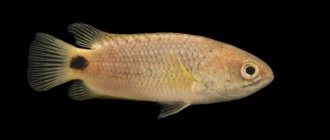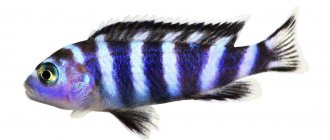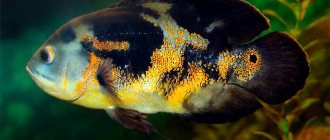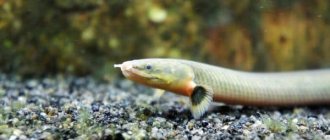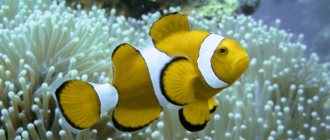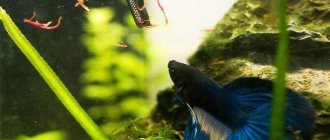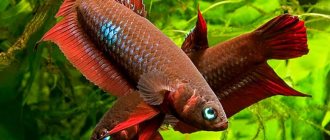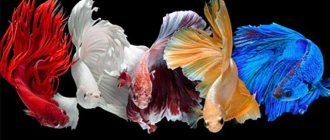Varieties
The betta fish was first selected in 1910, giving it a colored color. Today there are more than 10 species of betta. They differ from each other in color:
- plain (red, yellow, white, black, blue, turquoise, purple);
- two-color (the color of the fins differs from the body color);
- multicolor (marble color, butterfly, dragon).
And also by the type of fins.
| Betta Over Halfmoon |
Betta crowntail |
| Short-tailed cockerel (Betta Plakat) |
| Veiltail cockerel (Betta Veiltail) |
| Delta-tailed Betta (Betta Super Delta) |
Betta Double Tail |
| Elephant-eared cockerel (Dumbo) (Betta Dumbo) |
Betta fish coloring
According to color variations, cockerels after sectional work can be one-color or two-color, as well as multi-color. At the same time, the color itself, due to the selection carried out, will satisfy the needs of the most demanding and sophisticated aquarist.
In breeding work, the following colors of cockerels and, accordingly, types are distinguished:
1. Solid type is a rare and expensive color type of aquarium fish and in this case the most common color options for bettas will be red and green, white betta and black betta, as well as light green, blue and blue bettas.
2. Two-color or Cambodian - a color that comes in two options, when the body of the fish is pale in color, and the fins and tail contrast brightly with it. The second coloring option is when the fins are pale, but the body is brightly colored.
3. Butterfly - the body has a less bright color, which smoothly turns into brighter colors at the ends of the fins and tail. The colors in this case clearly contrast and do not mix with each other.
4. Marbled color is a color that vaguely resembles blue cheese, when there is a clear highlight of green or olive, black color against a pale background of the body.
5. Piebald - the head of the fish is poorly colored, and the body has an intense color that clearly contrasts with it, fins and tail; options with deviations from the butterfly and marble colors are acceptable.
6. Mask – deep, intense color of the head of the betta, in comparison with the rest of the body and most often it is copper and turquoise. A prominent representative is the Siamese cockerel.
7. Dragon - a new color, learned through long selection, the most common are red and silver, copper.
Compatibility of cockerels with other fish
A cockerel can live in an aquarium with other fish, but it is worth considering similar conditions of detention, nutrition and its aggressiveness. Small fish and representatives with large fins do not get along with the betta, and even eats snails.
| Get along well | They get along, but there are rare fights | Incompatible |
|
|
|
Feeding a betta fish in an aquarium
In natural conditions, cockerels most often feed on small insects and larvae, pluck algae, but in artificial reservoirs, in an aquarium, this can be either live food or a dry, combined composition.
As experienced aquarists advise, you need to alternate food, thereby diversifying it.
What to feed? Live food is best suited: live bloodworms and flies, cyclops and daphnia, as well as minced beef or fish, tubifex.
In addition, it is recommended to give the fry boiled egg yolk, as well as ciliates.
How to feed? The main thing here is not to overfeed, since males are prone to obesity, like any fish.
How much to feed? It is recommended not to feed the cockerels at all once a week, and on other days - a maximum of twice a day. If the betta fish does not eat, this indicates poor quality food or a pet illness.
How to distinguish a male from a female betta
Adult betta fish have fairly distinct sex differences. The male is larger, has a brighter color, and has longer fins. Until 2 months of age, it is much more difficult to distinguish a female from a male, but there are still several differences:
- the female has a wide and round ventral fin;
- a more rounded abdomen, on which the ovipositor (white dot) is visible;
- she is calmer and less aggressive.
Appearance and character of the betta fish
The betta fish is an aquarium inhabitant classified as a member of the macropod family; its ability to breathe atmospheric air allows it to be classified as a labyrinthine fish. The body is oval in shape, somewhat flattened on the sides and somewhat elongated in length.
The fins, in particular the upper and caudal ones, are round in shape, the pectoral ones are pointed, while in the male they are slightly longer than in the females. The color of cockerels is very diverse and unusual, obtained as a result of selection, since in natural bodies of water it is more faded and unsightly.
Cockerels can be single-colored or multi-colored, with the male being brighter in color. The brightness of the color is affected by lighting and nutrition.
If we talk about character, then this is a fairly aggressive fish towards each other, and only males. As a rule, aggression manifests itself if males are added to the aquarium as adults.
Bettas can bite goldfish or other inhabitants of the aquarium, but in most cases, with a large aquarium and normal conditions, the bettas are quite peaceful. The rule that will ensure their peaceful coexistence is to place the bettas in the aquarium at a young age, thereby nipping any conflict in the bud.
Reproduction
Males mature quickly and are considered sexually mature at the age of 4 months, and begin to reproduce at 6-8 months. A pair of the same breed, and preferably the same color, is suitable for breeding.
Preparation for spawning takes several stages:
- For spawning it is better to equip a separate aquarium. A 4-5 liter tank with a water level of no more than 10-12 cm is suitable. Soil is not placed at the bottom, but plants are needed. The female creates shelter in them, and the male often uses them to build a nest.
- It is advisable to separate the female and male from each other for a week, during which time the female’s abdomen will noticeably become rounder.
- Then the fish are allowed into the spawning aquarium and their temperature is constantly raised to 28-30°C, this stimulates spawning.
- The male will begin to build a nest of foam on the surface of the water, which takes him from 1 to 3 days. If the pair is selected successfully, spawning will begin within a couple of hours.
- During spawning, the male courts the female, picks up the eggs and carries them to the nest.
After the end of spawning, the male drives away the female (she needs to be removed), and he himself takes care of the eggs in the nest: adding bubbles, removing unfertilized eggs. When the fry hatch and begin to swim, the male also needs to be removed, otherwise he may crush the fry.
During one spawning, 200 eggs are released, about a third of them survive.
The history of the appearance of betta fish in aquariums
The homeland of this bright fish is considered to be the south and east of Asia, where the natural habitat of the betta is located. The slow-flowing rivers and reservoirs of Vietnam and Thailand are home to bettas.
The very first mention of this fish dates back to 1800, when the inhabitants of Siam noticed the excessive aggressiveness of the males of this breed and then began breeding a fighting breed for subsequent bets on money.
This breed of fish came to Europe in 1892. The very first countries that bred these fish were Germany and France, and in America they gained popularity since 1910. And it was there that they began to breed colored cockerels.
Cockerels arrived on the territory of Russia much earlier than in Germany; this significant event dates back to 1896 and is directly associated with the names of V.M. Desnitsky and V.S. Melnikova.
Caring for fry
The fry grow quickly and do not require much effort, you just need to follow some recommendations:
- in the first days, feed brine shrimp or ciliates.
- after 7 days you can already give specialized granulated food for fry or finely chopped tubifex;
- replace ¾ of the water in the aquarium daily;
- in 2-3 weeks it is advisable to sort large individuals from smaller ones;
- At the age of 4 weeks, the fry are transferred to a large aquarium.
Conditions and care for cockerels in the aquarium
In its keeping, the cockerel is considered a fairly unpretentious inhabitant of the aquarium and is easy to keep, since even a beginner can take care of it. But the cockerel has its own characteristics in the conditions of detention.
When talking about how to care for cockerels at home, you need to take into account the following rules and recommendations.
Aquarium volume for betta fish
The conditions for keeping these fish provide that artificial reservoirs can be either small in size, no more than 10-15 liters, or larger. The ratio must be observed: 4 liters of water per individual.
If volumes allow, then the aquarium is divided into sections and males are kept without harming them. Cockerels have the ability to jump out of the water and therefore it is best to cover an artificial pond with either a net or a lid with holes for air.
Water for betta fish
The optimal temperature is considered to be 24-27 degrees, but the fish tolerate a decrease to 18-20 degrees just fine. However, a long-term decrease in temperature indicators will have a detrimental effect on the appearance of the cockerels and the brightness of their color, their state of health, threatening many diseases and even the death of living creatures in some cases.
With regard to the quality of water and its composition, males are very undemanding, and for them it is better to maintain its hardness at the level of 4-15, and its acidity at the level of 6.0-7.5 pH.
A prerequisite for the proper maintenance of fish is the regular change of water in the aquarium. In very small aquariums, a complete water change is acceptable; in other cases, as a general rule, only 2/3 of the total volume of the aquarium is replaced with new water. The interval for such replacement in a large aquarium is once every 2 weeks, in a small aquarium - every 3-5 days.
Air for betta fish
Due to the fact that the betta is a labyrinth fish, it breathes both through gills and a special, additional organ in which the composition of the blood is saturated with oxygen captured by the fish on the surface, and then spread throughout the body.
Therefore, aeration in the aquarium for bettas is not as important as for its other inhabitants. But with all this, the main thing is not to forget to install filters in the artificial reservoir, albeit of low power, but capable of additionally purifying the water.
When keeping cockerels, it is important to remember that they do not tolerate strong currents and the surface of an artificial reservoir becoming overgrown with grass and algae, preventing them from rising to the surface and gasping for air.
If a film of bacteria or dust has formed on the surface of the water, this should also be removed. Remove the film using a simple sheet of paper, which acts like a sponge and removes the film quite easily.
Soil for betta fish
For a cockerel in an aquarium, it is enough to line the bottom with sand or fine gravel, which, before backfilling, is simply washed under running hot water, having previously been kept in a strong solution of potassium permanganate for two to three hours.
Plants for betta fish
In terms of plants, cockerels are unpretentious, and any vegetation can be planted in the ground, with the only condition that the plants do not cover the surface of the water. By volume, plants should occupy no more than a third of your entire aquarium.
Decor and lighting for the cockerel fish
Cockerels love to swim between snags and stones and hide in grottoes. The main thing is that they are all made from environmentally friendly materials and without sharp corners that can injure the fish.
It is forbidden to place the aquarium in a place exposed to direct sunlight, but otherwise the fish will not cause any trouble and will delight their owners with their beauty and bright colors.
Diseases
With good care at home, a cockerel can live for about 3 years. But if the aquarium is poorly maintained, overfed or fed with live food, there is a risk that the betta will get sick.
Diseases can lead to the death of a pet, so you should pay attention to the appetite and behavior of the fish, because these are the first signs of any ailment.
Fin rot:
- Symptoms. The edges of the fins first become dull, then erosion appears, which grows intensively over the entire surface of the fin. Then the process of rotting occurs, and the fin disintegrates.
- Causes. The causative agent of the disease is the bacterium Pseudomonas. It occurs due to poor quality or untimely cleaning of the aquarium, when feeding contaminated food or introducing infected fish and plants.
- Treatment is carried out with salt baths and streptocide. It is also important to disinfect the aquarium, change some of the water, and rinse the plants and soil.
Costiosis:
- Symptoms. A gray spot with copious mucus secretion and clouding of the skin are formed.
- Causes. The parasite is caused by a flagellate, which can be introduced into an aquarium with live food or infected fish.
- Treatment is carried out with furazalidone and malachite green. In this case, it is necessary to change the water by 20-30% every day. As a rule, fish recover within a week.
Dropsy:
- Symptoms are a swollen belly, raised scales, redness of the fins and abdomen, loss of appetite, apathy.
- Causes. Incorrect feeding of fish, supplementary feeding, infections.
- For treatment, use Bicillin 5, white streptocide, and a weak solution of potassium permanganate.
Ichthyophthiriasis:
- Symptoms. Small white dots (similar to semolina grains) appear on the fish's head, which spread throughout the body. Lethargy, loss of appetite, swims in jerks.
- Causes. Introduced into the aquarium with new fish or plants. The culprit may also be live food contaminated with ichthyophthyriasis.
- Treatment is carried out with salt baths, malachite green, bicillin 5, antipar preparations.
By following all the recommendations for caring for a cockerel, the fish will delight you with its beauty, absence of diseases and large offspring.
Differences between males and females
With good care, such pets can live from 2 to 3 years and grow up to 6-7 centimeters in length. Sexual differences between males and females in betta fish are pronounced. Males are larger than the fairer sex and have brighter and larger fins. In addition, a female betta can be identified by a white speck located near the anal fin. This is an ovipositor that appears during spawning.
Cockerels live 2-3 years
The differences between male and female bettas are worth considering in more detail, since this important information will be useful when keeping fish and breeding them. It is worth noting that it is quite easy to distinguish them, since the sexual characteristics of representatives of the Betta genus appear quite clearly.
These include:
- body size and structure;
- behavioral characteristics;
- shape and size of fins.
Looking at the fish, you can see that the fins of males are longer and larger than those of females. This criterion is considered the main one when determining sex, but it is not applicable if the aquarist’s pond contains short-tailed cockerels. In this case, you will again have to pay attention to the fins, but only to the anal ones. So, in boys they are elongated and elongated, and in girls they are short and rounded.
As already noted, adult females have an ovipositor in the shape of a small star just in front of the anus. But small fish do not yet have this feature, so this feature should not be considered when buying teenagers.
Before spawning, the body of dark-colored females is covered with vertical stripes to warn the males that they are ready to mate. But the scales of light-colored girls do not change their color, so this criterion is not applicable to them. However, upon careful examination of the females, you can notice that eggs are visible through their body.
Also, when determining gender, you should pay attention to the shape of the fish. Males are flexible and slender (their body tapers towards the tail and thickens closer to the head), while females are dense and stocky, and have a relief curve in the front part of the belly - this is where the caviar is located.
The differences in behavioral characteristics of male and female betta fish are quite ambiguous. Young girls, when in good health and development, can behave as aggressively as boys, especially during spawning:
- they arrange fights among themselves;
- show each other threatening poses, straightening their fins and protruding their gill covers.
Preparing for spawning
Breeding betta fish at home is not difficult and can be done by a beginner in the aquarium business. However, for a successful outcome of the event, the aquarium owner will need to comply with certain conditions:
- For spawning, a special aquarium with a volume of 15 to 40 liters and a height of at least 15 cm is prepared.
- A partition is installed inside such an aquarium so that the male and female can be separated.
- Care should be taken to arrange places where the female can hide from the temperamental cockerel while the partition is removed.
Important! You can determine the time for spawning by the appearance of the female - the abdomen is noticeably rounded.
- It is necessary to provide a sponge filter and a water heating system in the sedimentation tank.
- In the spawning tank, the temperature is maintained in the range from 26 to 28° and the water acidity level is from 6 to 7.5 pH.
- 1.5 - 2 weeks before the start of spawning, live food is added to the daily diet of the female and male. It is preferable to feed bloodworms.
Important! The aquarium must be kept clean, so uneaten food should be removed promptly.
- There should be no soil in the container where spawning will take place. The presence of stones can create a situation where eggs fall between them, and they can easily get lost in the sand.
- The future father himself is engaged in building a nest for his offspring. The cockerel swallows a small amount of oxygen and spits it out. The result is foam from small bubbles that are well attached to each other. The male makes a nest from them. You can place a small amount of small floating algae on the surface of the water (placing pistia and other analogues would be a good option) or pieces of foam - this will also serve as a good building material for the nest.
We suggest you read: What to do if your cat has colitis
Important! The female needs preventive spawning to maintain health, even if the owner of the aquarium did not intend to breed Siamese bettas.
What you need for spawning and raising fry
The fry develops quickly, so all the necessary equipment, aquariums, and some food must be prepared in advance. So, what can be useful for spawning:
- heaters for spawning and nursery aquariums;
- thermometer;
- spawning tank with a volume of 10 liters - a glass aquarium or a plastic food container;
- a nursery aquarium with a volume of at least 20 liters per hundred fry, preferably 2 - for sorting by size of babies at the age of 3 weeks;
- containers for raising young males, 1-3 liters each (only if it is possible to put them in a warm place where the water temperature will be at least 23°C);
- a compressor for incubating brine shrimp and, preferably, for fry up to three weeks old;
- two Artemia incubators;
- food: live or frozen bloodworms for preparing breeders and grown fry, dried or frozen brine shrimp eggs suitable for incubation, it is advisable to breed a rotifer culture for starters, frozen cyclops if it is not possible to purchase a live one.
Optional items include a dry leaf of ketapang or oak, riccia or a twig of a small-leaved plant floating near the surface, a cut bottle as a plastic nursery for the female.
Manufacturer training
Not all betta fish can spawn and care for their offspring normally. Imported fish are especially capricious, although in most cases it is difficult to determine good parents in advance. Many males who previously ate eggs become exemplary fathers after a change in conditions.
Bettas do not spawn in the second half of their lives, even if they look healthy and vigorous. Therefore, manufacturers should not be older than a year. Although you can take a female a little older, if she is not too large compared to the male. Bettas spawn most readily at the age of 4.5 to 7 months.
Healthy young males that receive adequate nutrition can spawn without preparation. But fish tortured in a store on dry food in glasses of dirty water will have to be cooked for 2-3 weeks. To do this, the male and female need to be seated if they lived together, and their temperature should be lowered to 24°C (the optimal temperature is 26°C).
Feed the breeders with live or frozen bloodworms quite generously, but without overfeeding, i.e. about 6-7 large bloodworms or a dozen medium ones per fish per day, divided into two doses. You can’t feed them so nutritiously on a regular basis - the cockerels quickly get fat. It would be nice to add some crustaceans to the menu: frozen brine shrimp, chopped shrimp or live daphnia. If the guy is somewhat phlegmatic, then you can put a mirror on him for several hours a day. When the hen has collected eggs, and the cockerel has perked up, gained strength and began to regularly build a nest, you can prepare a spawning ground. The day before, it is necessary to raise the temperature of the producers to 26°C.
Editorial: Platidoras
Description
The cockerel is a labyrinthine fish from the macropod family. The peculiarity is that it receives oxygen not only through the gills. The cockerel swallows air into its mouth, and thanks to a special respiratory organ, the blood is saturated with oxygen.
There are approximately 70 species of this fish, differing in color and size. Life expectancy is on average 4 years.
The cockerel has an elongated oval body, flattened laterally. The length of the fish is 4-5 cm. Males are slightly larger in size than females. Some species grow about 8-10 cm, these are veiltails. The caudal fin, as well as the upper one, have a rounded shape, and the pectoral fins have a pointed tip.
Males have longer fins and brighter colors. The colors of the cockerels are amazing in their diversity. They can shimmer in many colors. In some species, the scales shimmer in all shades of the rainbow.
The brightness of the color depends not only on the lighting. During spawning and an aggressive state, the color becomes brighter and more saturated.
The most popular species among aquarium fish lovers:
- veiltails,
- crescent tails,
- crowntails,
- double tails,
- roundtails,
- flagtails,
- royal.


